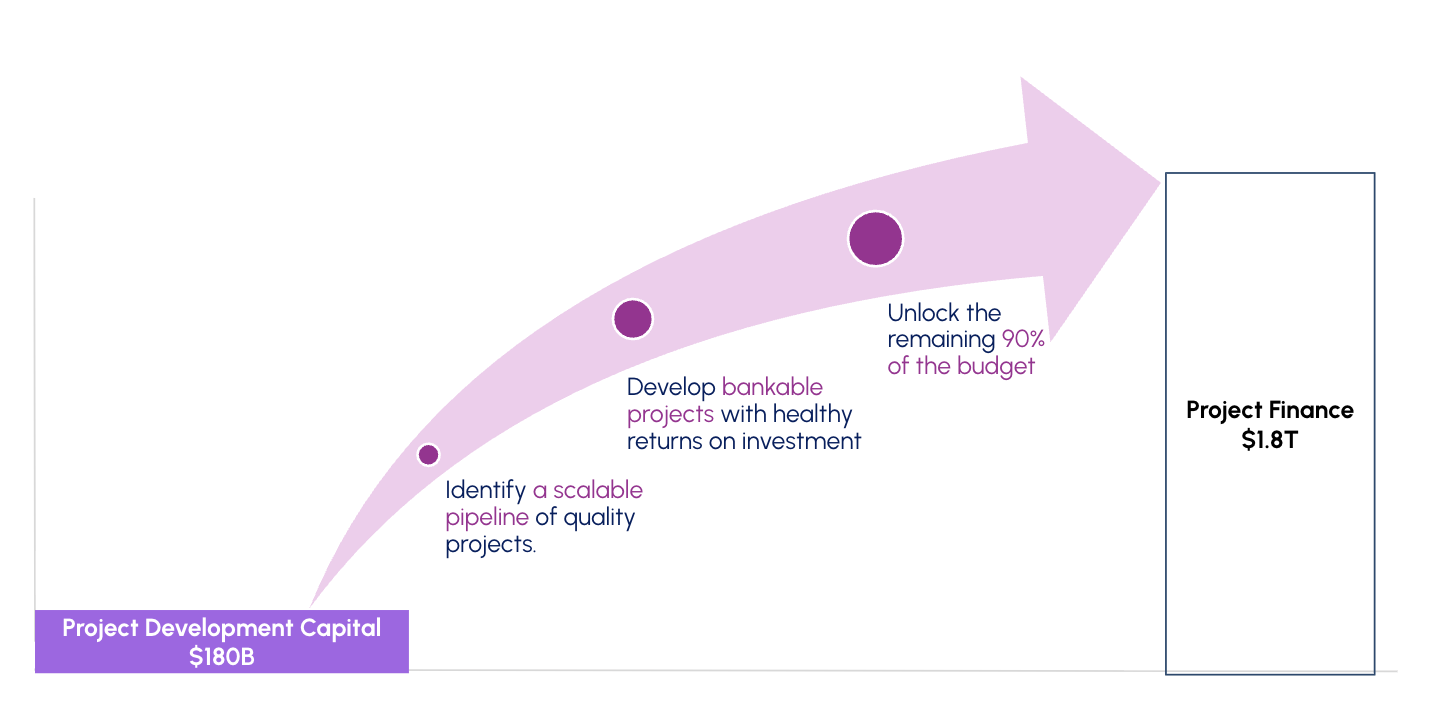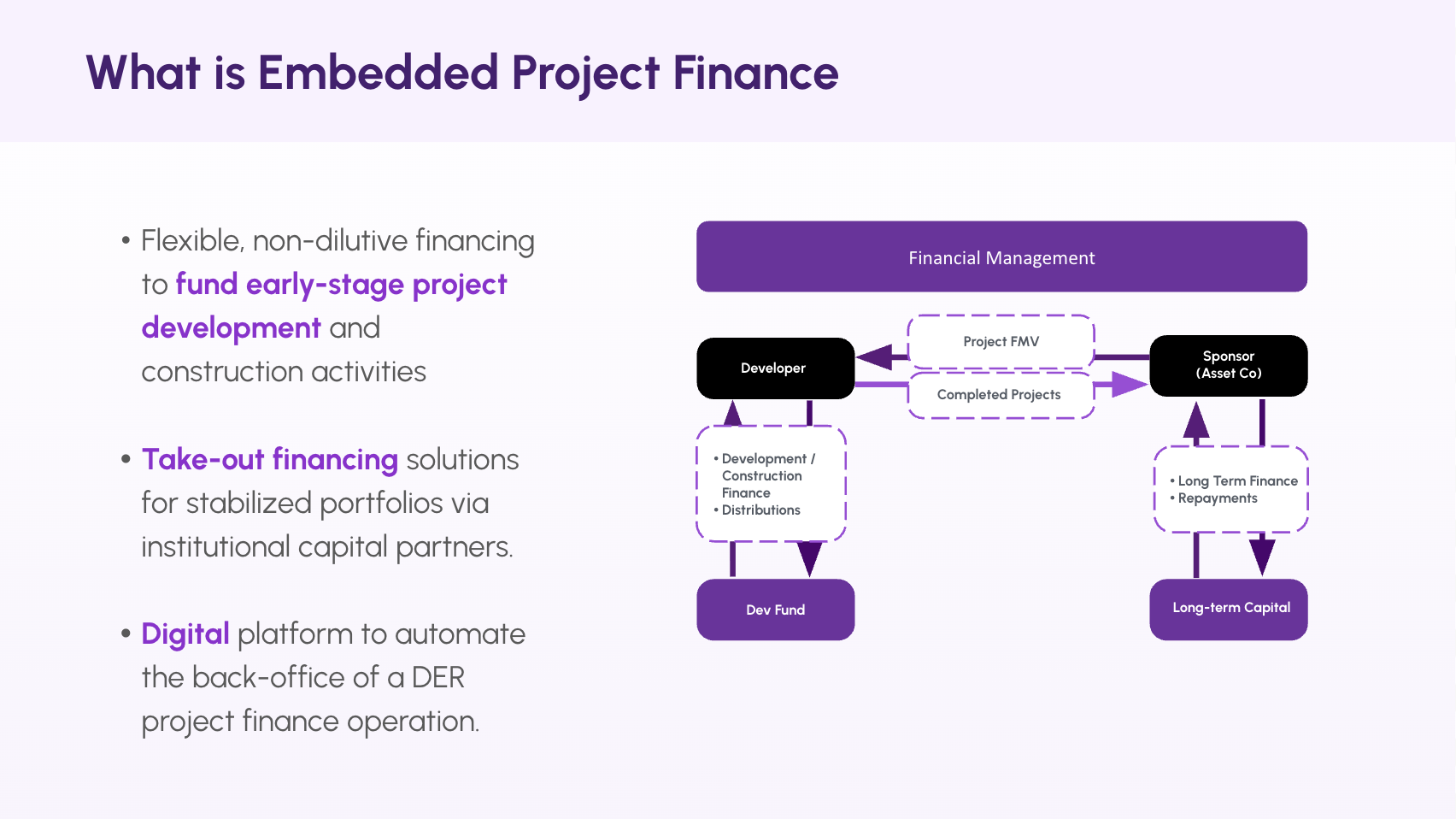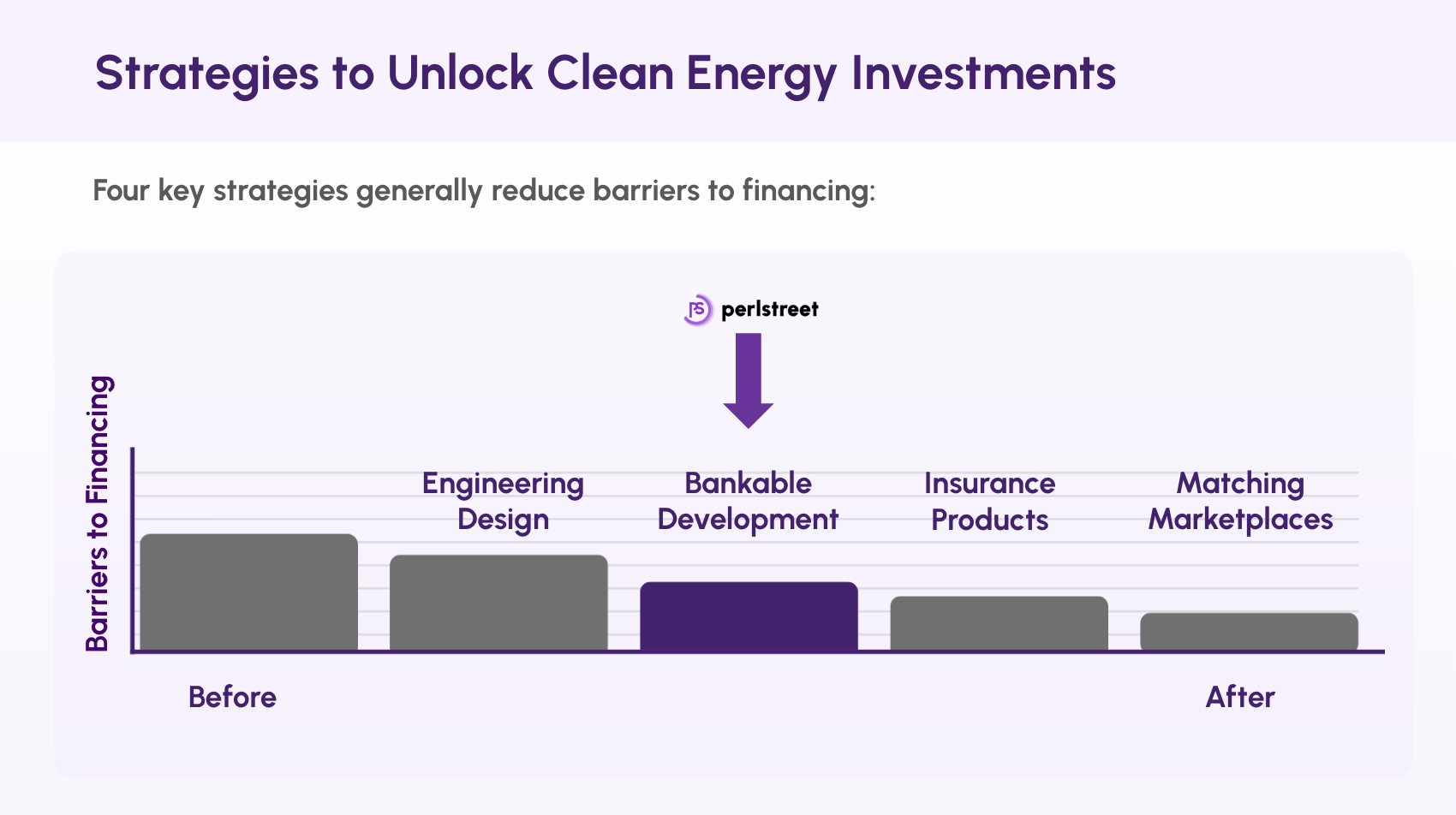Perl Street Embedded Project Finance: Unlocking Scale in Clean Energy

Buildings account for nearly 38% of global greenhouse gas emissions. Decarbonizing them represents a $1.3 to $1.8 trillion investment opportunity by 2030. Yet, a critical bottleneck persists: the earliest dollars of project development.
Roughly 10% of total project costs must be spent upfront—feasibility studies, interconnection deposits, permitting, legal, and early construction—before institutional investors will step in. That translates to $180 billion in development funding needed over the next five years just to unlock the larger wave of building decarbonization projects.

This is where Perl Street’s Embedded Project Finance (EPF) comes in. By combining flexible capital, long-term financing, and AI-enabled underwriting into one seamless system, EPF makes clean energy projects bankable faster, reduces risk for investors, and accelerates deployment at scale.
What Is Embedded Project Finance?
Embedded Project Finance has three key components:
- Flexible, non-dilutive financing to fund early-stage project development and construction activities.
- Take-out financing solutions for stabilized portfolios via institutional capital partners.
- Digital platform automation to handle the back-office of a DER project finance operation.
Let’s break down each component:
Development Capital
Development capital provides short-term, flexible funding to cover the most critical and riskiest parts of the project lifecycle:
- Development costs: Feasibility studies, interconnection deposits, legal and permitting, grants, rebates, and bridge financing.
- Construction costs: Materials and labor.
- Terms: Typically 1–3 years, with interest in the 17–23% range.
- Repayment: In milestones, or converts to permanent debt at COD.
These funds are structured in partnership with Perl Street’s network of investors, with Perl Street serving as the origination and structuring platform. Depending on the project, financing can either convert into permanent capital at COD or be prepaid as projects advance through milestones. This ensures projects have the essential early dollars to de-risk feasibility and move confidently into construction.
Permanent Capital Access
Once projects reach COD and stabilize, development capital is replaced with permanent financing designed for long-term durability and scalability. Options include:
- Green banks
- Private credit lenders
- C-PACE lenders
- Lease providers
- Tax equity and ITC direct pay marketplaces
- Cash equity partners
Typical structures:
- Interest: 8–13%
- Terms: 10+ years
- Repayment: Monthly or quarterly
These solutions are tailored to the project’s ownership model (TPO vs. direct ownership) and often combine multiple instruments—tax equity, direct pay, and cash equity—to create the optimal stack. The goal is to align projects with institutional-grade capital that supports long-term performance.
End-to-End Funding Management Platform & Services
The third pillar is the software layer that ties everything together. Perl Street’s platform is a complete backend system for executing and operating capital programs at scale, offering:
- Loan management and servicing
- Underwriting, credit memos, and cash flow modeling
- Real-time dashboards for lender and grantor coordination
- ITC and incentive compliance
- Ongoing asset and investor reporting
Ultimately, the platform’s role is to achieve true bankability—not by targeting a single funder, but by making projects viable across a wide range of capital providers.

Who Uses Embedded Project Finance?
EPF is designed to serve a diverse set of stakeholders across the clean energy ecosystem:
- OEMs & Hardware Manufacturers – Embed financing into hardware-as-a-service models for EV chargers, batteries, and HVAC systems.
- Developers & EPCs – Accelerate deal origination, reduce underwriting time, and move more projects through the pipeline.
- Sustainability Leaders – Access capital to achieve ESG targets without heavy internal capital expenditure battles.
- Investors & Funders – Gain access to pre-underwritten opportunities with transparent, data-rich due diligence.
- Utilities & Aggregators – Bundle DERs into no-upfront-cost customer offerings to build grid value.
- Consultants & Modeling Platforms – Use Perl Street to turn technical audits and models into finance-ready outputs.
Together, these groups illustrate how embedded finance is not limited to one niche of the energy sector—it’s a connective layer that aligns capital and technology across the entire clean energy value chain.
Why Bankability Matters
Development is the riskiest stage of the project lifecycle. Without clear evidence of bankability, projects stall. EPF tackles this by evaluating projects against 67 distinct risk criteria, grouped into categories like title, environmental, sponsor, capacity, and credit. The outcome is a Shadow Score—a configurable “bankability rating” that matches projects instantly with capital providers aligned to their risk profile.
Configurable Risk Weights: Investors can adjust the relative weight of risks (e.g., ownership vs. environmental risk) to fit their appetite.
This process slashes underwriting timelines, reduces failed diligence cycles, and helps developers and investors focus only on viable deals.
The Seven Pillars of Bankability
From Perl Street’s experience, truly bankable projects rest on seven pillars:
- Sponsor Capacity – Proven track record in DERs, microgrids, or efficiency projects.
- Consortium Structure – Clearly defined roles and risk allocations backed by formal agreements.
- Project Economics – Transparent financial models with credible revenue streams.
- Capital Stack – Validated pathway to permanent financing (rebates, incentives, tax equity).
- Technology & Risk Management – Solid O&M, permitting, and construction plans.
- Revenue & Credit – Bankable PPAs or ESAs with strong counterparties.
- Environmental Compliance – Impact assessments and compliance readiness.
Projects that check these boxes are significantly more likely to close financing on favorable terms.
Why Modular, Distributed Assets?
Tooraj emphasized that Perl Street’s strategy focuses on distributed, modular assets (DERs, batteries, efficiency retrofits). Modular systems follow manufacturing-style cost curves that reduce cost and risk from first-of-a-kind (FOAK) to nth-of-a-kind (NOAK) projects.
In contrast, volumetric, custom-engineered projects often introduce more EPC complexity and overhead as they scale, which can actually erode equity value. This is why Perl Street centers its vertical strategy on modular, repeatable project types.
Case Study: ThinkBox & Vesta
When Vesta Corp. needed $30 million across 14 distributed sites in 14 cities, developer ThinkBox turned to Perl Street. Using the platform, ThinkBox:
- Qualified each project within hours.
- Generated comparative cash flow analyses for Vesta.
- Received competing quotes from multiple lenders.
Capital was placed in under 48 hours—a process that typically drags on for weeks.
This case illustrates the leverage of embedding finance directly into the development process: faster timelines, better terms, and higher investor confidence.
How AI Enhances Project Finance
The third pillar of EPF is automation through AI. Perl Street’s Unety and AI Co-Pilot platforms streamline underwriting and contract diligence:
- Unety reconciles tax parcel vs. mailing addresses, aggregates valuation, title, and environmental datasets (Melissa, DataTree, EDR), and synthesizes 3,000+ property data points into eight underwriting categories. Unety currently covers ~90% of U.S. properties (needs verification). The output is a clear, auditable bankability score.
- Preliminary Project Financial Analysis Tool – Developers input basic parameters (cost, revenues, OPEX, fees, margins). The tool benchmarks against fund requirements, checks whether the project meets targets (e.g., fund MOIC ≥ 1.2), and automatically generates a working financial model. This can be embedded or white-labeled on third-party websites and can output a full Excel model to capital partners.
- AI Co-Pilot ingests project documents—EPC contracts, ESAs, PPAs, financial models—and checks them against configurable bankability criteria. For example, it can flag when a warranty sum is insufficient relative to upfront costs, prompting quick correction and resubmission.
- Deal Room Automation ensures that once issues are resolved, a fully structured, funder-ready data room is instantly available.
The outcome? Developers save weeks in diligence prep, while investors gain transparency and trust.
However, it stands to emphasize that adoption depends on explainability. The platforms must show what data was used and how it reached a conclusion so funders can audit the outputs.
Four Strategies to Unlock Clean Energy Investments
Broadly, the industry relies on four strategies to address financing barriers:
- Engineering Design Optimization – Enhancing project economics via advanced modeling.
- Bankable Development – Strengthening sponsor, consortium, and contract quality.
- Insurance Products – Transferring non-traditional risks into insurable formats.
- Marketplaces – Standardizing financial products to connect capital with projects.
Perl Street focuses on Bankable Development while collaborating with organizations in the other three lanes. The strategies are complementary—when combined, they maximize project success and scale.

Conclusion: Toward Data-Driven Clean Energy Finance
AI-enabled Embedded Project Finance is more than a funding model—it’s a scalable infrastructure for decarbonization. By embedding capital directly into projects and automating the back office of project finance, EPF:
- Reduces friction in underwriting.
- Expands access to a broader pool of capital.
- Unlocks trillions in climate investment potential.
As Perl Street’s Co-Pilot demonstrates, AI acts like a team of junior analysts, tirelessly scanning contracts and financials. Yet human judgment remains central—AI enhances decision-making rather than replacing it. Transparency, auditability, and configurability ensure funders and developers can trust the process.
The clean energy transition demands speed and scale. Embedded Project Finance is how we get there.
Ready to See It in Action?
Book a demo today to explore how Perl Street’s Embedded Project Finance can accelerate your projects: perlstreet.com/contact-us.
